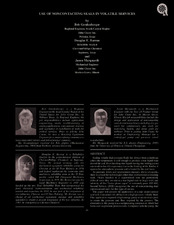| dc.contributor.other | International Pump Users Symposium (20th : 2003) | |
| dc.creator | Goodenberger, Bob | |
| dc.creator | Barron, Douglas E. | |
| dc.creator | Marquardt, Jason | |
| dc.date.accessioned | 2017-10-05T15:52:08Z | |
| dc.date.available | 2017-10-05T15:52:08Z | |
| dc.date.issued | 2003 | |
| dc.identifier.uri | https://hdl.handle.net/1969.1/164015 | |
| dc.description | Lecture | en |
| dc.description | pg. 33 | en |
| dc.description.abstract | Sealing volatile high-pressure fluids has always been a challenge unless the temperature is cold enough to produce a true liquid state around the seal. Even handling true liquids having low boiling points can result in low life expectancy due to the flashing of the fluid as it approaches atmospheric pressure and is heated by the seal faces. As pressure levels and temperatures increase above cryogenic, there is a need for technologies other than conventional contacting seals. Fluids handled in a supercritical state are particularly difficult since they are not in a true liquid state to begin with, and lubricity of the “dense phase vapor” is extremely poor. API 682, Second Edition, (2002) recognizes the use of noncontacting dual unpressurized seals for this type of service. This paper will present the application of a dual unpressurized seal with noncontact lift-off faces to a high-pressure volatile fluid. This application required a high-energy pump at an elevated speed to create the pressure and flow required by the process. The alternative to this pump was a reciprocating compressor, which had been used on previous process units. Compared with the pump compressor option would have been significantly more expensive to purchase and would have resulted in increased maintenance over the life of the process unit. The pump selected was a nine-stage barrel pump rotating at 6686 rpm driven by an electric motor through a gearbox. The fluid being pumped was ethylene. Suction pressure was 950 psig. The ethylene was chilled to an operating temperature of 50 F so that the pump could develop the head necessary to produce the required discharge pressure of 4450 psig. The seals selected have now run for over two years with no failures. This includes several issues with the pump during which the pump was disassembled to correct vibration problems. At these times, the seals were removed from the pump and were not even reconditioned but were just reinstalled. Under similar conditions, a contacting seal would have been reconditioned each time the seals were removed and would have had an ultimate life expectancy of only six months. | en |
| dc.format.medium | Electronic | en |
| dc.format.mimetype | application/pdf | |
| dc.language.iso | en | |
| dc.publisher | Texas A&M University. Turbomachinery Laboratories | |
| dc.relation.ispartof | Proceedings of the 20th International Pump Users Symposium | en |
| dc.subject.lcsh | Pumping machinery | en |
| dc.title | Use Of Noncontacting Seals In Volatile Services | en |
| dc.type.genre | Presentation | en |
| dc.type.material | Text | en |
| dc.identifier.doi | https://doi.org/10.21423/R1T68T | |


